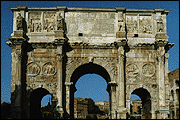ARCH OF CONSTANTINE
 |
The impressive Arch of Constantine stands next to the Colosseum.
It's one of the largest arches built by the Romans, is well preserved and features a lot of very fine sculptures.
Luckily its proximity to the Colosseum brings the idle wanderer over to find out what it is and be rewarded by what it offers. |
In order to read the monument be aware that the North facade faces the Colosseum, while the East short side faces the Palatine and the arch of Tito.
Constantine was the emperor who brought a semblance of peace to a Rome that had been fraught with civil war on and off for a hundred years. He gained power by defeating the emperor Maxentius in the famous battle of the Milvian Bridge in 312 CE. The arch was built for Constantine by the Senate and people of Rome in 315 CE to commemorate his victory over Maxentius.
The Arch of Constantine has three portals and is richly decorated with statues and carved reliefs, though many of them were pillaged from earlier structures. The eight statues around the upper story were from a monument of Trajan's time and represent Dacian warriors against whom Trajan had fought a successful war. The Aurelius panels between them come from monuments built for the emperor Marcus, the medallions (between the portals and the upper story) come from Hadrian's time (117-138), but the heads were remaked and represent Costantine and Licinio. While the medallions on the short sides and other works of the arch are contemporary of Costantine.
But the masterpiece of the arch is the Trajan relief which was pillaged from the Trajan forum and divided into four parts to be inserted in the arch. This relief, 20 meters long and 3 high, is the greatest one survived.
The reliefs that were executed expressly for the arch tell of episodes from the war against Maxentius. These works, which form a band around the monument, can easily be differentiated from the earlier sculptures by their lack of realism; the standards of artisanship had declined during the continual civil wars of the previous century.
The eight columns of the arch lean above pedestals yet of the Costantine period.
For all the reasons above mentioned this arch is known as the four Emperors arch and is considered the most important Roman open air museum.
back |

